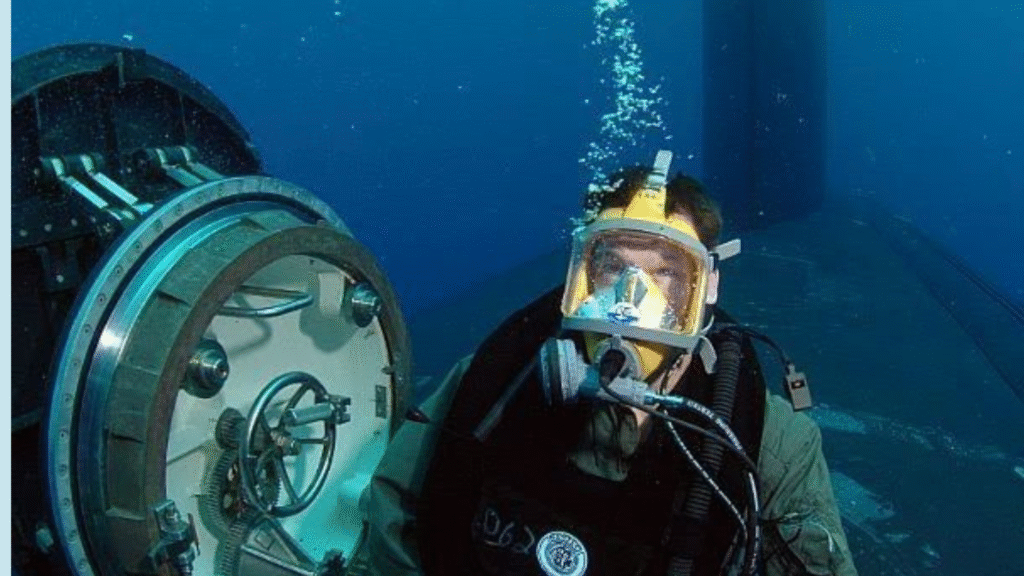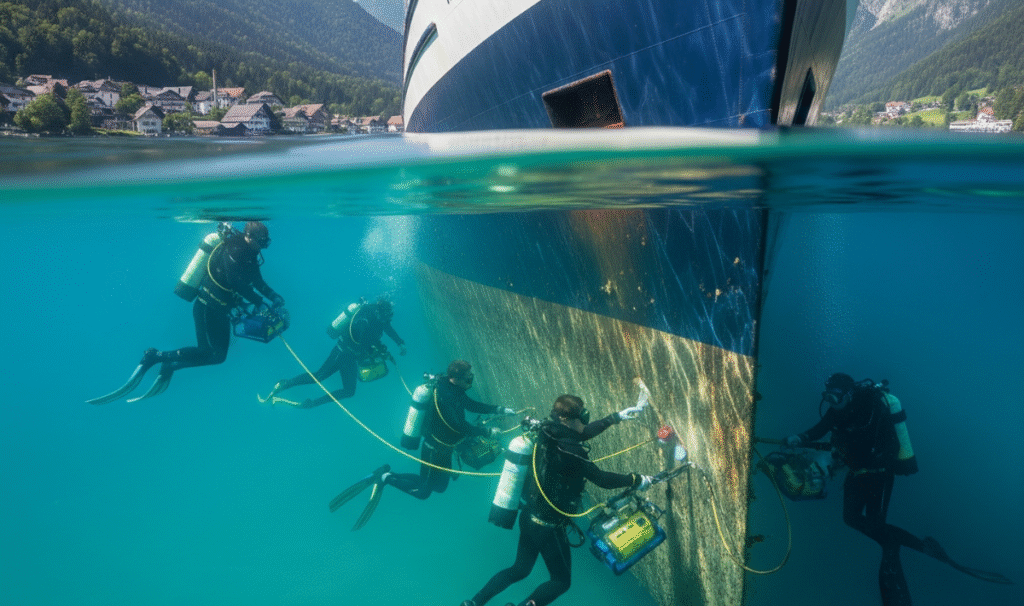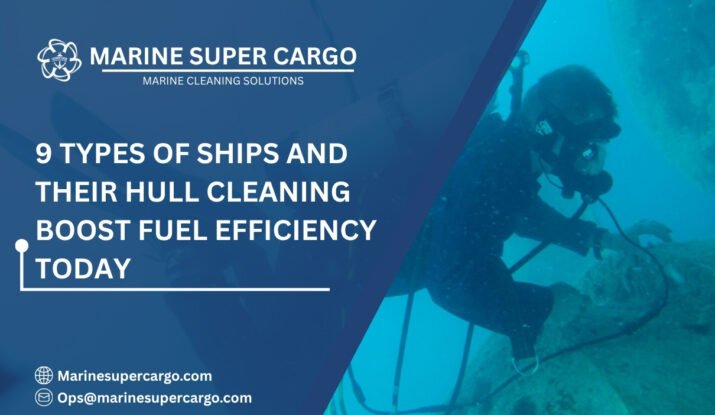Think of a ship and its hull cleaning as its protective skin—it shields the vessel, supports its weight, and directly impacts performance and fuel efficiency. Just like human skin, hulls require regular care to remain effective. However, types of ships vary greatly, and so do their fouling challenges, making ships and their hull cleaning a critical aspect of modern maritime operations.
Tankers carry heavy liquids, container ships face high-speed water resistance, ferries operate in shallow, coastal waters, and cruise liners must maintain pristine appearances—highlighting the importance of ships and their hull cleaning for optimal performance.
Understanding the types of ships and their specific hull cleaning requirements is essential for safety, efficiency, and compliance. Modern shipping increasingly relies on tailored strategies suited to each vessel type, highlighting why knowing the types of ships is no longer optional but critical.
Why Ships and Their Hull Cleaning Matter
The hull is like a ship’s invisible engine booster. A foul-free hull reduces drag, saves millions in fuel, and lowers emissions. When neglected, fouling acts like a thick coat of mud on running shoes—slowing ships down while forcing engines to burn more fuel, highlighting the importance of ships and their hull cleaning for efficiency and sustainability.
Consequences of poor cleaning include:
- Up to 40% rise in fuel consumption.
- Shortened paint and coating lifespan.
- Risk of MARPOL violations for biofouling discharge.
- Higher greenhouse gas emissions.
These reasons make knowing the types of ships and their hull cleaning needs more than just technical—it’s about protecting compliance, profits, and the planet.

Cargo Vessels, Container Ships and Their Hull Cleaning
Container ships are the backbone of global trade, transporting goods across long distances and busy shipping lanes. Their hulls face heavy fouling, particularly along equatorial and coastal routes where algae, barnacles, and other organisms thrive.
The hull profile—long, flat, and wide—creates a vast surface area that demands thorough and regular cleaning. Modern maintenance often combines robotic hull cleaning with occasional diver-assisted brushing to preserve smooth coatings and minimize drag, emphasizing the importance of ships and their hull cleaning for optimal performance.
For operators, a consistent hull condition is crucial: it not only ensures fuel efficiency but also keeps port schedules and cargo delivery commitments on track, directly affecting operational costs and reliability.
11.39% of Inspected Cargo Shipments Contained Deficiencies In 2024, WSC Says
— MarineInsight (@MarineInsight) September 10, 2025
Read the news here 👉https://t.co/p93QFS1I8Y#Cargo #Shipment #Ship #WSC #Maritime #MarineInsight #Merchantnavy #Merchantmarine #MerchantnavyShipshttps://t.co/p93QFS1I8Y
Oil and Chemical Tankers
Oil and chemical tankers often remain at anchor in warm, nutrient-rich waters while waiting for loading or discharge slots, creating ideal conditions for biofouling. Their hulls feature large, flat surfaces that are particularly prone to barnacle and algae settlement, which can increase drag and fuel consumption.
Effective maintenance requires frequent underwater inspections and proactive cleaning schedules, often supported by waste collection systems to comply with MARPOL and environmental regulations.
Strict spill-prevention and safety standards, monitored under IMCA guidance, make hull cleaning critical. Delayed maintenance on tankers can quickly escalate into serious environmental risks and significant economic losses for operators.
Bulk Carriers
Bulk carriers, transporting raw materials like coal or iron ore, often operate in mixed climates.
- Hull profile: Deeper draught hulls require specialized cleaning in lower regions.
- Cleaning needs: Longer turnaround times allow port-based robot cleaning.
- Challenges: Dense fouling with calcareous organisms after tropical voyages.
For them, scheduling preventive hull cleaning ensures coatings aren’t eroded after just a few voyages.
Read Also: Underwater Ship Hull Cleaning in Egypt.
Passenger and Cruise Ships
Cruise ships are floating cities. Their hulls are under constant scrutiny for aesthetics and regulatory checks.
- Hull profile: Larger overall hull surface compared to cargo carriers, sensitive to drag.
- Cleaning needs: Eco-friendly robotic systems with waste capture—authorities in destinations like Australia or New Zealand enforce strict standards.
- Added pressure: Customer perception. A stained hull damages reputation as much as efficiency.
Operators benefit from frequent cleaning strategies tied into port calls, often coordinated with local regulators via IAPH guidelines.
Ferries and Short-Sea Vessels
Unlike long-haul cargo carriers, ferries perform high-frequency trips with minimal downtime.
- Hull profile: Shorter but subjected to repetitive biofouling in shallow, nutrient-rich coastal waters.
- Cleaning needs: Light-touch, frequent cleaning rather than deep scrubbing. Robotic tooling provides speed in turnaround.
- Key challenge: Scheduling maintenance without causing travel delays.
Here, efficiency isn’t just lowering costs but maintaining punctuality for passengers and cargo alike.
Naval Vessels
Warships and coast guard vessels add another dimension—speed and stealth. Any fouling compromises performance and acoustic signature.
- Hull profile: Advanced coatings (anti-fouling and low-friction), requiring delicate cleaning approaches.
- Cleaning needs: Minimal abrasive methods to avoid damage, often using highly specialized divers and robotic solutions.
- Strategic importance: Hull efficiency is directly tied to defense readiness.
For navies, hull maintenance is not just compliance—it’s about operational security.
Offshore Support Vessels (OSVs)
OSVs include supply ships, anchor handlers, and platform support crafts. These often station themselves near rigs, making them static for extended periods.
- Hull profile: Medium-sized vessels, but they sit idle longer than standard cargo ships.
- Cleaning needs: Aggressive fouling removal due to immobility, often requiring full robotic interventions.
- Environmental implications: MARPOL Annex V requires safe disposal of biofouling waste.
With offshore operations already costly, unchecked fouling adds unnecessary expenditure.
Fishing Vessels
Fishing fleets often lack access to large-scale cleaning facilities, yet they face some of the toughest fouling conditions.
- Hull profile: Varied shapes, mostly smaller hulls with manual cleaning traditions.
- Cleaning needs: Economical diver cleaning supported by portable robotic systems.
- Challenge: Balancing low budgets with efficient compliance.
Given their reliance on small margins, every fuel percentage saved matters.
Compliance and Environmental Factors
IMO Biofouling Guidelines:
- Focus on preventive hull cleaning to minimize the transfer of invasive marine species.
- Encourage ships to maintain clean hulls before entering new ports, reducing ecological impact.
MARPOL and IAPH Regulations:
- Many ports under the International Association of Ports and Harbors (IAPH) enforce independent inspections to ensure compliance.
- Waste collection, discharge limits, and environmentally safe cleaning methods are mandatory.
Operator Responsibilities:
- Ship operators must balance cleaning costs with regulatory compliance.
- Non-compliance can lead to port delays, fines, or sanctions.
Strategic Impact:
- Tailoring hull cleaning strategies to different types of ships ensures operational efficiency, cost-effectiveness, and marine protection.
- Modern hull maintenance integrates safety, sustainability, and competitiveness in global shipping operations.
Cost-Saving Outcomes
A properly maintained hull = cost savings, reduced downtime, and compliance security.
Benefits include:
- 5–20% lower fuel usage.
- Extended coating lifecycles.
- Reduced GHG emissions, aiding ESG reporting.
- Fewer disruptions by port state controls.
Treat hull cleaning like preventive healthcare—spend less now to avoid huge bills later.
The Future of Ships and Their Hull Cleaning
The future of hull cleaning is being shaped by cutting-edge technology and sustainable practices, moving far beyond traditional diver-based methods.
Future Fuels and Technologies Hub: Explore the latest on new marine fuels and innovation.
— International Maritime Organization (@IMOHQ) September 9, 2025
Read the full story here: https://t.co/uqhZrKoweh #MarineFuels #GHG #IMO pic.twitter.com/jtvucLjwzo
AI-Driven Robotic Cleaners:
Autonomous robots capable of self-deploying at ports are being developed to perform precise hull cleaning with minimal human intervention. Using advanced sensors and machine learning, these systems can detect fouling early, scrub surfaces efficiently, and even assess coating conditions in real time.
Nanotechnology-Based Coatings:
Innovative hull coatings with self-polishing and anti-fouling properties are reducing the adhesion of marine organisms. These nanostructured surfaces extend maintenance intervals, lower fuel consumption, and minimize environmental impact by replacing toxic biocides with eco-friendly alternatives
Fleet Data Integration and Predictive Analytics:
Data collected by robots and onboard sensors can be integrated into fleet management platforms, helping operators predict the optimal cleaning schedules. This ensures cost-effective maintenance, reduces downtime, and improves fuel efficiency.

Eco-Focused, Smart Maintenance:
- Future ships and their hull cleaning strategies will combine predictive analytics with green technologies, tailoring care to each vessel’s unique needs. This approach not only enhances operational efficiency but also supports sustainable shipping, aligning with IMO regulations and global decarbonization goals.
In essence, the next generation of ships and their hull cleaning is automated, intelligent, and environmentally responsible, promising safer operations, lower costs, and a greener maritime industry.
Conclusion
Understanding the types of ships and their hull cleaning needs is essential to keep global shipping smooth, safe, and sustainable.
Key takeaways:
- Ship type determines hull cleaning strategies, costs, and compliance requirements.
- Cleaner hulls improve efficiency, extend coating life, and reduce emissions.
- Future innovations will blend robotics, AI, and eco-friendly coatings for maximum benefits.
For tailored solutions that balance cost, performance, and compliance, explore the offerings at CleanShip.co today.
FAQ:
1. Why is hull cleaning important for every ship type?
Hull cleaning reduces drag, improves fuel efficiency, and extends coating life. Each ship type has unique fouling patterns that demand customized cleaning approaches.
2. How do regulations affect ship-specific cleaning?
IMO and MARPOL rules enforce biofouling management and waste disposal, ensuring ships clean responsibly depending on their operational routes and hull types.
3. What ship type benefits most from robotic ships and their hull cleaning?
Large ships like container vessels, tankers, and cruise liners benefit most due to their size, strict compliance needs, and higher fuel savings potential.
4. Which ship types can use divers instead of robots?
Fishing vessels, ferries, and smaller support vessels often use divers due to cost, size, and accessibility. Larger ships usually require robotic cleaning solutions.
5. What’s the future of Ships and Their Hull Cleaning?
Advances will include AI-enabled cleaning robots, self-polishing coatings, and predictive data systems, making ships and their hull cleaning faster, greener, and cost-efficient.


